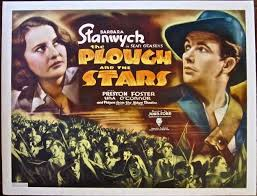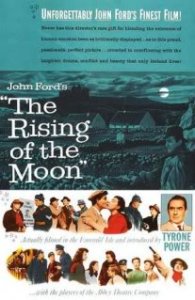John Ford was an Irish – American director. In a career exceeding fifty years, he directed more than one hundred and forty films. Although he is more famous for making westerns such as Stagecoach and The Searchers; Ford also made some Irish films, frequently using the same actors and depicting a visual metaphor. In many films, Ford used Abbey players such as Barry Fitzgerald and Cyril Cusack to represent stage Irishness. They would often star alongside a larger, bulkier actor such as John Wayne and Victor Mc Laglen – tying in with the visual metaphor of depicting the geographical size difference of England and Ireland. This ideology is depicted articulately in The Informer.
The Informer (1935) was adapted from Liam O` Flaherty`s novel. It conveys the story of Gypo Nolan (Victor Mc Laglen); an Irish rebel who informs on friend, Frankie Mc Philip and suffers the consequences. Throughout the diegesis representations of masculinity are formulated by Gypo and Terry. Terry, played by J.M Kerrigan is one of Ford`s first stage Irishmen. In many films, Ford uses Abbey actors to depict an unreliable Irish character. This establishes the idea of a dilution of masculinity whereby the Irish character would seem weak in an overall context. In The Informer, this is accomplished through various mechanisms of Terry`s character. Firstly, his peak cap is worn over his face which distances him from the audience. Additionally, he verbally abuses a drunken Gypo and abandons him after assuming he has spent his £20 (a reward obtained for informing on Frankie). However, once he realises that he hasn’t; Terry quickly returns to Gypo`s side. Subsequently, Terry`s deceitful nature is framed expressionistically through dimly lit interiors and foggy exterior shots of streets. This is parallel to Gypo`s confused and drunken stupor in which Terry takes advantage. Throughout this film, masculinity is re-affirmed in two ways: it moves away from stage actors on screen to film actors. For example, Gypo`s transition from soldier to an informer is presented metaphorically in biblical terms as `Judas` for informing on a friend and later as an image of Christ when he reaches atonement.
In The Plough and the Stars (1936), Ford worked with Abbey actors again. Adapted from Sean O` Casey`s play, it details events leading up to the 1916 Rising. However, Ford`s version differs in a cinematic context. Instead of focusing on the troubles, Ford places emphasis on character relationships. Further evidencing of re-affirmation of masculinity in different circumstances is the integral position of the romantic plot line which becomes much more important to the film. Through this the war is over shadowed as personal relationships takes precedence. Moreover, the idea of gender reversal is considered in terms of space. Public spaces are generally defined as male and domestic as female but Ford inverts these gendered spaces throughout the narrative. An example of this occurs with the framing of a prostitute in the pub. Incidentally, Irish players are culpable for blurring boundaries of gender also. This is demonstrated through Barry Fitzgerald`s character, Fluther. Throughout the diegesis, Fluther is portrayed more cowardly than in the play. Rather than fighting, he cowers behind a wall when he is accidently shot at. In retaliation, he throws a flower pot out of the window. His missile connected with bullets and grenades exploding in the background mark the division between male and female spaces.
In 1952 John Ford introduced the world to his Irish western: The Quiet Man. Originating from a story by Maurice Walsh, it took twenty years to make. As with many of his westerns, Ford represented masculinity predominately through the figure of John Wayne. He portrays an `outside` character Sean Thornton who returns home from America to buy back his family home. Although he is welcomed back by many, Will Danaher (Victor Mc Laglen) takes an instant dislike towards him. Their hostility for one another is only resolved in a long and memorable fight that results in gaining mutual respect. As he lived most of his life in America, Sean isn’t familiar with Irish customs. The dowry causes marital problems between he and Mary-Kate as it represents different ideologies. To Mary-Kate it represents independence but to Sean it is a haunting reminder of his life in America. However, Rev. Playfair conveys the veracity of Sean`s past to the audience. Through this, he helps resolve Sean`s martial issue with Mary-Kate by enabling him to understand what the dowry really represents for his wife. Conversely, Barry Fitzgerald represents Ford`s stage Irish idea once more. Throughout the narrative, he portrays the comical drunk to detract from serious issues evolving (particularly concerning Sean and Mary-Kate).
The Rising of the Moon (1957) is a compilation of three short films based on works of Irish writers. In The Majesty of the Law, The doubling standards of characters are apparent. Sergeant Michael Dillon objects to moonshine brewed in public but not the actual act. Dan O` Flaherty admits to respecting the law but also the arts `of which moonshine making is one`. Furthermore, space is visually represented by Mickey J: he is framed between two worlds: illegality on the outside and tradition on the inside. A minute`s Wait is a vaudeville – like routine where nothing happens nine times. Stage Irishness is framed as performance within a performance diegetically. Performance is dramatically emphasised when passengers and train workers burst into song in the station house. A high angle shot is used to replicate a theatre performance for the audience. In 1921, Ford used stage Irishness as a move toward a particular stylistic development. Joseph O` Dea is considered responsible in assisting IRA fugitive, Sean Curran, escape. Here, O` Dea is framed as stage idiot who feigns innocence about Curran`s disappearance. Through this doubling, both the audience and black and tans are deceived.
Throughout his Irish films, John Ford represented ideas of masculinity. With the use of Abbey players, amongst others, he developed characters of different methodologies. They may not have always appealed to critics and spectators,but John Ford always worked with the best and those masculine characters will live for generations to come.
Work Cited:
The Informer. Dir. John Ford. Radio Pictures: 1935. Film
The Plough and the Stars. Dir. John Ford. RKO Pictures: 1936. Film.
The Quiet Man. Dir. John Ford. Republic Pictures: 1952. Film
The Rising of the Moon. Dir. John Ford. Four Provinces Film: 1957. Film,




